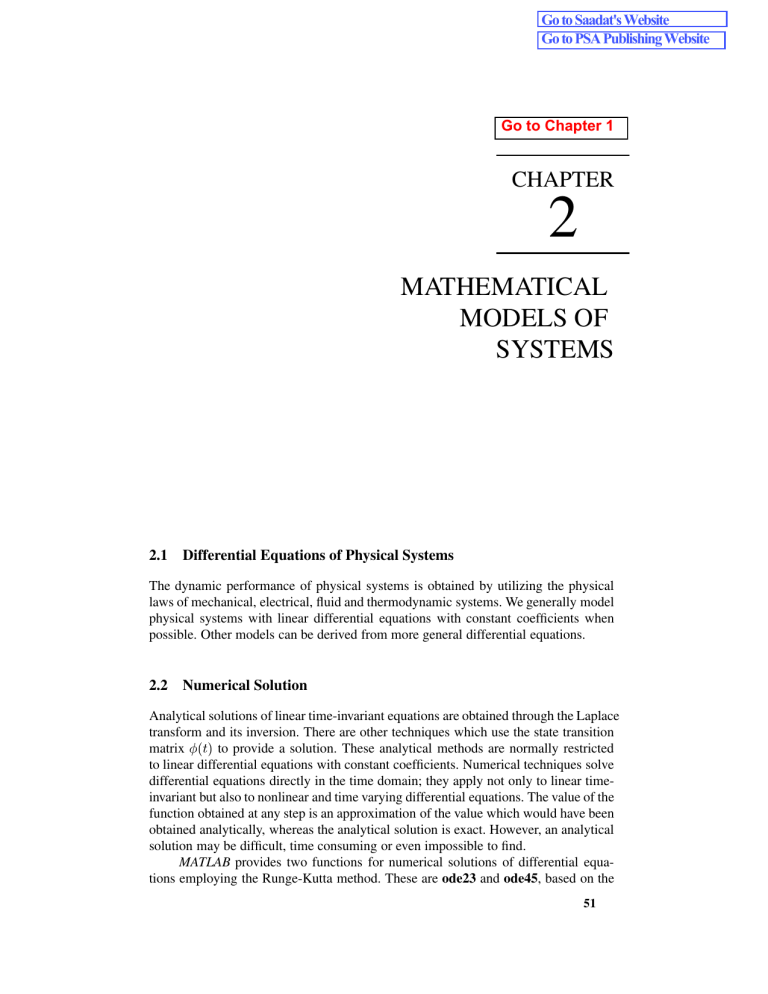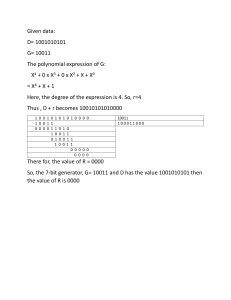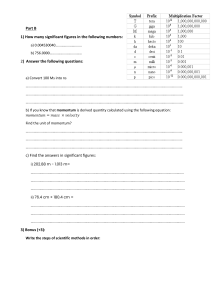Mathematical Models of Systems: Differential Equations & Numerical Solutions
advertisement

Go to Saadat's Website
Go to PSA Publishing Website
Go to Chapter 1
CHAPTER
2
MATHEMATICAL
MODELS OF
SYSTEMS
2.1 Differential Equations of Physical Systems
The dynamic performance of physical systems is obtained by utilizing the physical
laws of mechanical, electrical, fluid and thermodynamic systems. We generally model
physical systems with linear differential equations with constant coefficients when
possible. Other models can be derived from more general differential equations.
2.2 Numerical Solution
Analytical solutions of linear time-invariant equations are obtained through the Laplace
transform and its inversion. There are other techniques which use the state transition
matrix t to provide a solution. These analytical methods are normally restricted
to linear differential equations with constant coefficients. Numerical techniques solve
differential equations directly in the time domain; they apply not only to linear timeinvariant but also to nonlinear and time varying differential equations. The value of the
function obtained at any step is an approximation of the value which would have been
obtained analytically, whereas the analytical solution is exact. However, an analytical
solution may be difficult, time consuming or even impossible to find.
MATLAB provides two functions for numerical solutions of differential equations employing the Runge-Kutta method. These are ode23 and ode45, based on the
()
51
52 2. Mathematical Models of Systems
Fehlberg second and third order pair of formulas for medium accuracy and fourth and
fifth order pair for high accuracy. The nth-order differential equation must be transformed into n first order differential equations and must be placed in an M-file that
returns the state derivatives of the equations. The following examples demonstrate the
use of these functions.
Example 2.1
Consider the simple mechanical system of Figure 2.1. Three forces influence the motion of the mass, namely, the applied force, the frictional force, and the spring force.
... ... ... ... ... ... ... ... ... ... ... ...
.... .... .... .... .... .... .... .... .... .... .... ....
........
...
..
.
.... ..
........... ..............
.... ..
..
.
.
.
.
.
.
.
.
.
..........................
...
.
... .
........... ................
.... ..
..
.
..
........
.......... .........
..
..
..
...
..
..
...
............................
K
B
...
.
........
...
.
()
M
x t
...
.
..........
...
.
()
f t
FIGURE 2.1
Mechanical translational system.
Applying Newton’s law of motion, the force equation of the system is
M
Let x1
= x and x2 = dxdt , then
dx1
dt
dx2
dt
d2 x
dt2
+ B dx
+ Kx = f (t)
dt
= x2
= M1 [f (t)
Bx2
Kx1
]
With the system initially at rest, a force of 25 Newton is applied at time t = 0. Assume
Kg, frictional coefficient B
N/m/sec., and the spring
that the mass M
N/m. The above equations are defined in an M-file mechsys.m as
constant K
follows:
= 25
=1
=5
function xdot = mechsys(t,x);% returns the state derivatives
F = 25;
% Step input
M =1; B = 5; K = 25;
xdot = [x(2) ; 1/M*( F - B*x(2) - K*x(1) ) ];
The following M-file, ch2ex01.m uses ode23 to simulate the system over an
interval of 0 to 3 sec., with zero initial conditions.
2.2. Numerical Solution
Time response of mechanical translational system
3
2
displacement
1
velocity
0
−1
0
0.5
1
1.5
2
Time − sec.
velocity versus displacement
2.5
3
3
velocity
2
1
0
−1
0
0.2
0.4
0.6
0.8
displacement
1
1.2
FIGURE 2.2
Response of the mechanical system of Example 2.1.
tspan = [0, 3]
;
% time interval
x0 = [0, 0];
% initial conditions
[t,x] = ode23('mechsys', tspan, x0);
subplot(2,1,1),plot(t,x)
title('Time response of mechanical translational system')
xlabel('Time - sec.')
text(2,1.2,'displacement')
text(2,.2,'velocity')
d= x(:,1); v = x(:,2);
subplot(2,1,2), plot(d, v)
title('velocity versus displacement ')
xlabel('displacement')
ylabel('velocity')
subplot(111)
Results of the simulation are shown in Figure 2.2.
1.4
53
54 2. Mathematical Models of Systems
Example 2.2
=14
()
=2
()
= 0 32
0
: ,L
H, and C
: F, the initial
The circuit elements in Figure 2.3 are R
inductor current is zero, and the initial capacitor voltage is .5 volts. A step voltage of
. Determine i t and v t over the range < t <
1 volt is applied at time t
sec. Also, obtain a plot of current versus capacitor voltage.
=0
.... ...
........
.... .....
.... .......
...
Vs
1:4
i(t)
2H
... ... ... ...
....................................
...................................................... ... ... ... ..
.. .. .. ..
...
................
............
=1V +
+
()
0:32 F
vc t
FIGURE 2.3
RLC circuit for time-domain solution example.
Applying KVL
Ri
di
+ L dt
+ vc = Vs
and
i
= C dvdtc
Let
x1
= vc
x2
=i
and
then
_ = C1 x2
x1
and
_ = L1 (Vs
x2
x1
Rx2
)
The above equations are defined in an M-file electsys.m as follows:
function xdot = electsys(t,x);
% returns the state derivatives
V = 1;
% Step input
R =1.4; L = 2; C = 0.32;
xdot = [x(2)/C ; 1/L*( V - x(1) - R*x(2) ) ];
15
2.2. Numerical Solution
55
Time response of an RLC series circuit
1.5
Capacitor voltage
1
0.5
Current
0
−0.5
0
5
10
Time − sec.
Current versus capacitor voltage
15
0.15
Current
0.1
0.05
0
−0.05
−0.1
0.5
0.6
0.7
0.8
0.9
1
Capacitor voltage
1.1
1.2
1.3
FIGURE 2.4
Response of the series RLC circuit of Example 2.2.
The following M-file, ch2ex02.m, uses ode23 to simulate the system over an interval
of 0 to 15 sec.
x0 = [0.5, 0];
% initial conditions
tspan=[0, 15];
% time interval
[t,x] = ode23('electsys',tspan, x0);
subplot(2, 1, 1),plot(t,x)
title('Time response of an RLC series circuit')
xlabel('Time - sec.')
text(8,1.15, 'Capacitor voltage')
text(8, .1, 'Current')
vc= x(:,1); i = x(:,2);
subplot(2, 1, 2),plot(vc, i)
title('Current versus capacitor voltage ')
xlabel('Capacitor voltage')
ylabel('Current'), subplot(111)
Results of the simulation are shown in Figure 2.4.
56 2. Mathematical Models of Systems
2.3 Nonlinear Systems
A great majority of physical systems are linear within some range of the variables.
However, all systems ultimately become nonlinear as the ranges are increased without
limit. For the nonlinear systems, the principle of superposition does not apply. ode23
and ode45 simplify the task of solving a set of nonlinear differential equations as
demonstrated in Example 2.3.
Example 2.3
=
Consider the simple pendulum illustrated in Figure 2.5 where a weight of W mg kg
is hung from a support by a weightless rod of length L meters. While usually approximated by a linear differential equation, the system really is nonlinear and includes
viscous damping with a damping coefficient of B kg/m/sec.
.
..........
......
....
....
.
.
.
...
....
....
....
....
.... ....
....
....
.
....
.....
.... ............. .
.
.
.
.....
...
....
..
....
.
.
.
.
.
.
.
...
...
.
....
....
....
....
....
.
.
.
.
.
.
..
..
....
....
...
....
....
.
.
.
.
.
.
.
.
..
.
...
..........
....
.....
.
....
.
.
.
....
....
.
.
.
.
...
..
...
.
....
....
...
..
....
.........
..
...
.
L
{
mg
FIGURE 2.5
Pendulum oscillator.
If in radians is the angle of deflection of the rod, the velocity of the weight
at the end will be L and the tangential force acting to increase the angle can be
written:
_
FT
=
W
sin _
BL
From Newton’s law
FT
= mL
Combining the two equations for the force, we get:
+ BL_ + W sin = 0
mL
Let x1
= and x2 = _ (angular velocity), then
x_1 = x2
_=
x2
B
x2
m
W
mL
sin x1
The above equations are defined in an M-file pendulum.m as follows:
2.3. Nonlinear Systems
57
Time response of pendulum on rigid rod
4
Velocity
2
Angle−Rad.
0
−2
−4
0
1
2
3
Time − sec.
Phase plane plot of pendulum
4
5
Angular velocity
4
2
0
−2
−4
−1
−0.5
0
Position − Rad.
0.5
1
FIGURE 2.6
Response of the pendulum described in Example 2.3.
function xdot = pendulum(t,x);%returns the state derivatives
W = 2; L = .6; B = 0.02; g = 9.81; m = W/g;
xdot = [x(2) ; -B/m*x(2)-W/(m*L)*sin(x(1)) ];
The following M-file, ch2ex03.m, uses ode23 to simulate the system over an
interval of 0 to 5 sec.
tspan = [0, 5];
% time interval
x0 = [1, 0];
% initial conditions
[t,x] = ode23('pendulum', tspan, x0);
subplot(2,1,1),plot(t,x)
title('Time response of pendulum on rigid rod')
xlabel('Time - sec.')
text(3.2,3.1,'Velocity'), text(3.2,1.2,'Angle-Rad.')
th= x(:,1); w = x(:,2);
subplot(2,1,2),plot(th, w)
title('Phase plane plot of pendulum')
xlabel('Position - Rad.'), ylabel('Angular velocity')
Results of the simulation are shown in Figure 2.6.
58 2. Mathematical Models of Systems
2.4 Linearization
Nonlinear systems are often linearized assuming small signal conditions. The nonlinear differential equation describing the motion of the pendulum in Example 2.3 can be
, the pendulum
linearized if the initial angle of deflection is small. When 0
equation can be written as
= +
( + ) + BL(_ + _) + W sin( + ) = 0
(2.1)
For small assuming sin ' 0 , cos ' 1 and expanding the sine term
mL yields the following linear differential equation.
+ BL_ + W = 0
mL (2.2)
It is left as an exercise to show that the above linearized equation will yield
approximately the same response as long as is small.
2.5 Transfer Function
The transfer function of a linear, time-invariant, differential equation system is defined
as the ratio of the Laplace transform of the output variable to the Laplace transform of
the input variable, with all initial conditions assumed to be zero. Although the transfer function can be used only for linear systems, it yields more intuitive information
than the differential equation. The characteristic equation is obtained by setting the
denominator polynomials of the transfer function to zero. The roots of the denominator are the system poles, and the roots of the numerator are the system zeros. The
system transfer function can then be specified to within a constant by specifying the
system poles and zeros. The constant, usually denoted by K , is the system gain factor. The transfer function model enables us to change system parameters and rapidly
sense the effect of these changes on the system response. The transfer function is also
useful in modeling the interconnection of subsystems by forming a block diagram
representation. The time response of a system is obtained by the inverse transform of
the s-domain response. This usually requires expansion of the rational function using
partial fractions.
In this section, several examples are presented to demonstrate the use of MATLAB in finding the roots of the characteristic equation, poles and zeros of a transfer
function, partial fraction expansion, and transformation of poles and zeros to transfer
function.
The Control System Toolbox function sys = tf(num, den) creates a continuous-time
transfer function. The output sys is a tf object. For SISO models, num and den are
row vectors listing the numerator and denominator coefficients in descending powers
of s. For example, the commands
num=[1 4]; den=[1 2 10];
sys=tf(num, den)
results in
2.5. Transfer Function
59
Transfer function:
s + 4
-------------s^2 + 2 s + 10
2.5.1
Polynomial Roots and Characteristic Polynomial
If p is a row vector containing the coefficients of a polynomial, roots(p) returns a
column vector whose elements are the roots of the polynomial. If r is a column vector
containing the roots of a polynomial, poly(r) returns a row vector whose elements are
the coefficients of the polynomial.
Example 2.3
Find the roots of the following polynomial.
s6
+ 9s5 + 31:25s4 + 61:25s3 + 67:75s2 + 14:75s + 15
The polynomial coefficients are entered in a row vector in descending powers.
The roots are found using roots.
p = [ 1 9 31.25 61.25 67.75 14.75 15 ]
r = roots(p)
The polynomial roots are obtained in column vector
r =
-4.0000
-3.0000
-1.0000
-1.0000
0.0000
0.0000
+
+
-
2.0000i
2.0000i
0.5000i
0.5000i
Example 2.4
1 2 3 4
,
,
j . Determine the polynomial equation.
The roots of a polynomial are
In order to enter a complex number, it is first necessary to generate a complex
unit. The roots are then entered in a column vector. The polynomial equation is obtained using poly as follows:
i = sqrt(-1)
r = [-1 -2 -3+4*i -3-4*i ]
p = poly(r)
The coefficients of the polynomial equation are obtained in a row vector.
p =
1 9 45 87 50
Therefore, the polynomial equation is
s4
+ 9s3 + 45s2 + 87s + 50 = 0
60 2. Mathematical Models of Systems
Example 2.5
Determine the roots of the characteristic equation of the following matrix.
2
A=4
0
6
6
1
11
11
13
65
5
The characteristic equation of the matrix is found by poly, and the roots of this
equation are found by roots.
A = [ 0 1 -1; -6 -11 6; -6 -11 5];
p = poly(A)
r = roots(p)
The result is as follows:
p =
r =
2.5.2
1.0000 6.0000 11.0000 6.0000
-3.0000
-2.0000
-1.0000
Poles and Zeros of a Transfer Function
tf2zp finds the zeros, poles and gains of a transfer function.
Example 2.6
Find the poles and zeros of the following transfer function:
3
2
( ) = s4 + 9ss3 ++1145ss2 ++3087ss + 50
H s
num = [ 1 11 30 0];
den = [ 1 9 45 87 50];
[z,p,k] = tf2zp(num,den)
The zeros, poles and gains are:
z =
p =
k =
-6.0000
-5.0000
0.0000
inf
-3.0000
-3.0000
-2.0000
-1.0000
1
+4.0000i
-4.0000i
2.5. Transfer Function
61
Therefore
(s + 5)(s + 6)
( ) = (s + 1)(s + s2)(
s + 3 + j 4)(s + 3
H s
j
4)
zp2tf forms transfer function polynomials from the zeros, poles and gains of
systems.
Example 2.7
6 50
A system has zeros at , , , poles at
the system transfer function.
3j 4 , 2, 1, and a gain of 1. Determine
z = [-6; -5; 0]; k=1;
i = sqrt(-1);
p = [-3+4*i; -3-4*i; -2; -1];
[num, den] = zp2tf(z,p,k)
The above program results in
num =
den =
1
1
11 30 0
9 45 87 50
which yields the following transfer function
3
2
( ) = s4 + 9ss3 ++1145ss2 ++3087ss + 50
H s
2.5.3
Partial-Fraction Expansion
[r,p,k] = residue[b,a] finds the residues, poles, and direct terms of a partial fraction
expansion of the ratio of two polynomials
( ) = bm sm + bm 1 sm 1 + + b1 s + b0
( ) ansn + an 1sn 1 + + a1 s + a0
P s
Q s
(2.3)
Vectors b and a specify the coefficients of the polynomials in descending powers of
s. The residues are returned in column vector r, the pole locations in column vector
p, and the direct terms in row vector k.
Example 2.8
Determine the partial fraction expansion for
3
( ) = s32+s s+2 +9s4+s +1 4
F s
62 2. Mathematical Models of Systems
num = [ 2 0 9 1];
den = [ 1 1 4 4];
[res, poles ,k] = residue(num, den)
The result is as follows
res =
0.0000
0.0000
-2.0000
-0.2500i
+0.2500i
0.0000
0.0000
-1.0000
+2.0000i
-2.0000i
poles =
K =
2.0000
Therefore the partial fraction expansion is
2 + s +21 + sj 0+:25j 2 + s j 0:j252 = 2 + s +21 + s2 1+ 4
[num, den] = residue(res, poles, K) converts the partial fraction expansion back to
the polynomial P s =Q s .
() ()



